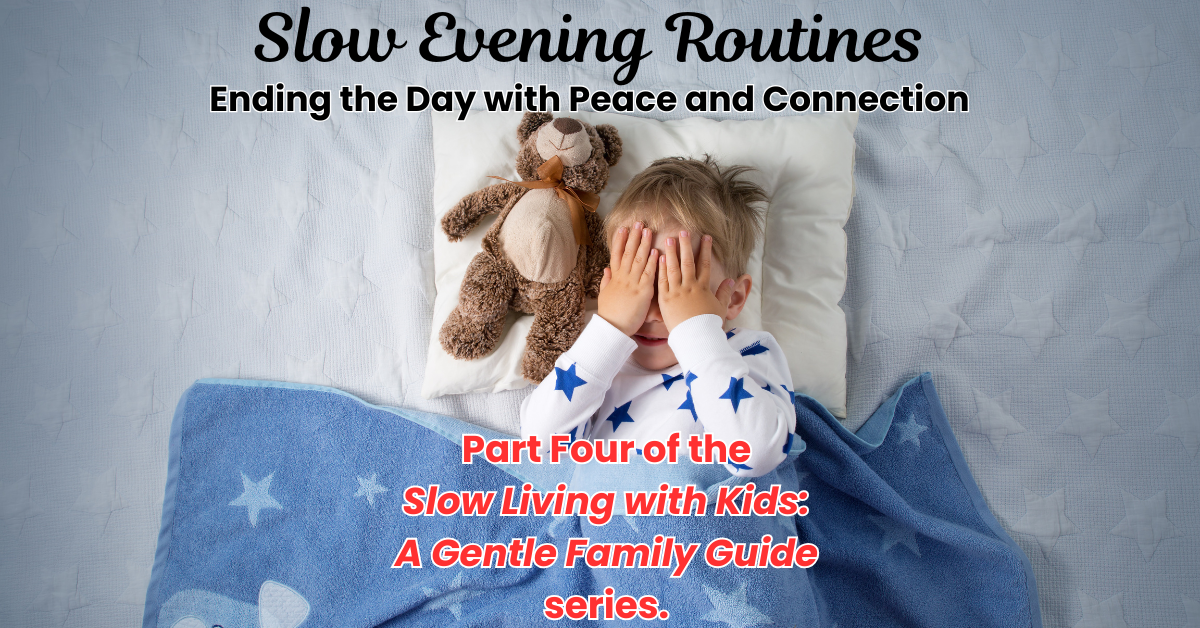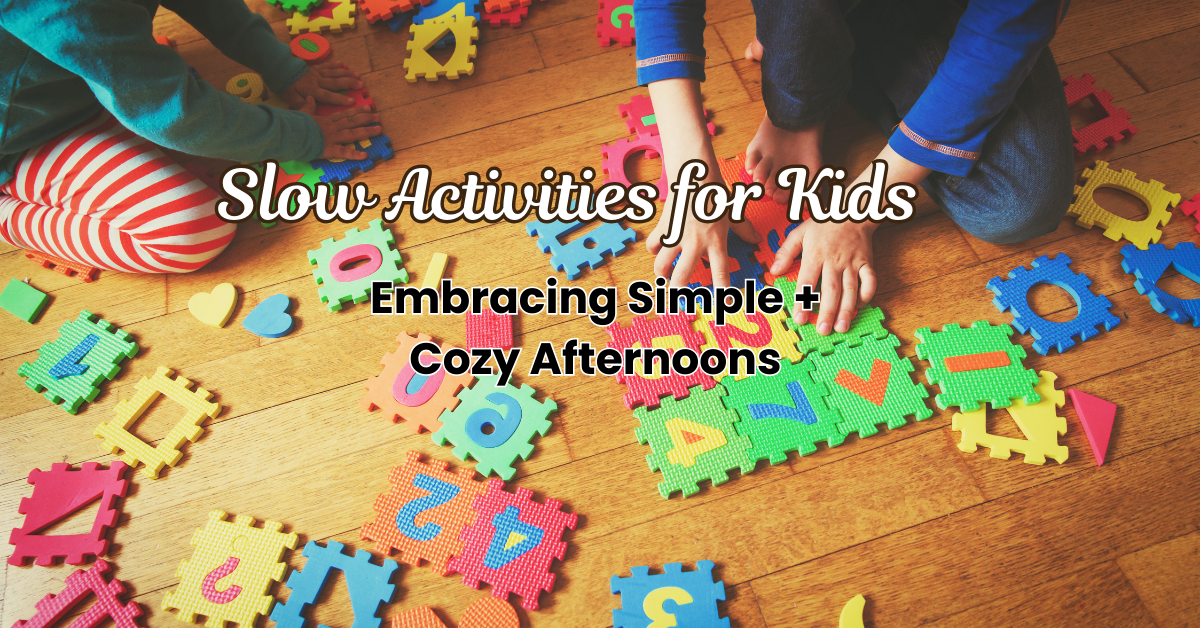Anyone else feel like the time between school pick-up and going to bed is the most chaotic part of the day? Even more so than hurried mornings getting everyone out the door on time? Just me? Okay. Some of you are lying. I can’t be the only one who feels this way. Evenings with kids can easily turn into the most chaotic part of the day. Everyone is tired, dinner needs to be made, bedtime is coming, and suddenly the whole house feels rushed. Enter: Slow Evening Routines.
What if I told you evenings didn’t have to be this way? What if, instead of hurrying through dinner and racing toward bedtime, we could see this part of the day as an opportunity to slow down, reconnect, and ease into a restful night?
That’s the heart of slow evening routines for families.
Rather than seeing evenings as something to “get through,” slow living invites us to see them as peaceful, cozy hours where family life unfolds in simple, intentional ways.
This post may contain affiliate links, which means I may earn a small commission if you choose to make a purchase—at no extra cost to you. I only share products I truly love and believe will add value to your life. Thank you for supporting this cozy corner of the internet!
Why Slow Evening Routines Matter
Evenings set the tone not only for sleep, but for how your family feels connected and cared for. A slow evening routine helps in so many ways:
- Creates calm after busy days. Kids (and parents) need a way to release the day’s energy.
- Strengthens family connection. Dinnertime, stories, or gentle rituals build memories and closeness.
- Improves rest. Calmer evenings help everyone transition to sleep more smoothly.
- Adds predictability. Kids thrive on routine and knowing what comes next.
Simple Slow Evening Routines for Families
Here are some ways to create slow evening routines that can bring calm and peace to your home.
1. Create a Cozy Transition
Evenings often start when everyone gets home. For us, that’s between 5:00 and 5:30. Try creating a small habit to mark the shift:
- Light a candle. Even a flameless candle will work great. They give that same ambience, and a little peace of mind if you’re like me, and nervous about flames. We have this set and they’re great.
- Put on soft background music.
- My kids’ favorite after school habit is coming home and eating ALL the snacks while they tell me about their day. If your kids are like mine, you’ll need to set a snack limit so they actually eat dinner.
- When that is said and done, the best part about coming home is putting on your comfies. Let your kiddos change into theirs as well.
This signals that the day is slowing down and we are unwinding.
2. Make Dinner a Time for Connection
2. Make Dinner a Time for Connection
Dinner doesn’t have to be fancy to be meaningful. The point isn’t what’s on the table, it’s how you share it.
- Talk to your kids about their day. Hopefully you get more than an “I don’t know” like I get every time I ask. Ask them what their favorite part of the day was. Ask them what they would have changed if they had the power. Ask them their favorite thing they learned. Ask them anything.
- Tonight my 4-year-old asked if he could help unload the dishwasher while dinner was getting ready. He unloaded the whole thing. Let your kids help with some aspect of dinner. It makes them feel proud of themselves. Let them help set the table, even if it isn’t perfect. Let them stir the sauce or soup. Let them measure out (with help) the seasonings. Kids love helping any way they can.
- Your kids aren’t really going to care how fancy your dinner is. All they want is to spend that time with you. Meal time doesn’t have to be overwhelming. Keep your meals simple and nourishing. Sometimes all my kids want is Greek yogurt with fruit. At least they’re getting protein.
3. Add a Gentle After-Dinner Activity
Instead of rushing straight into bedtime routines, consider one slow, cozy habit:
- Take a family walk around the block. If you have dogs, get them in in it too. Take a little basket or some sort of container to collect treasures in. Make up stories about the houses in your neighborhood. Meet the neighbors.
- Snuggle up on the couch and read a favorite book together.
- Play a few rounds of your kid’s favorite board game. In our house its Hi-Ho-Cherry-Oh or Bluey Candyland. Each round goes fast so play a few.
- Embrace the seasons and pick activities accordingly. Make hot chocolate with lots of mini marshmallows in winter. Sit and watch a sunset in summertime. Pick a bouquet of flowers for the table on a warm spring evening.
It doesn’t need to be a long activity,just something that invites connection before winding down.
4. Create a Tech-Free Hour
Screens can overstimulate kids, and adults in the evening. If possible, designate the hour before bedtime as “screen-free.” Fill it with quieter playing, reading, or talking instead.
This shift alone can completely change the atmosphere of your evenings.
5. Gentle Bedtime Routines
Bedtime is where slowing down shines. Predictable, calming routines help kids get ready for rest. Try:
- A warm bath or shower. Adding in calming bath soaps like lavender scented body washes if good for the senses and promotes better sleep.
- Use twinkle lights or soft lamps instead of harsh overhead lights.
- Storytime or read-aloud books. My daughter is learning to read so part of her bedtime routine is reading the bedtime books out loud.
- A prayer, blessing, or gratitude ritual.
- Tucking them in with their favorite blankie and a kiss.
Practical Tips for Parents
It’s easy to picture dreamy evenings, but harder to live them out with little ones. Here are some ways to make your slow evening routines realistic:
- Start small. Pick one or two things that matter most (like dinner together + storytime).
- Use candlelight or lamps. Shifting the lighting immediately signals that it’s time to wind down. We have a string of soft white lights around our TV that we plug in and turn all the other lights off.
- Batch prep earlier. Even small things like laying out pajamas or pre-setting toothbrushes make evenings flow better. Pro tip- also get backpacks ready and lunches made to help your mornings be stress free as well.
- Expect imperfection. Some nights will be wild. That’s okay, slow living is about finding your families’ rhythm, not rigid rules.
- Join the calm. If you’re rushing, your kids can feel it. If you slow down, they will follow your lead.
A Sample Slow Evening Flow
Here’s what a simple, gentle evening routine might look like:
- 5:30 – Dinner together. Your kids might help set the table or make dinner. Talk about your days.
- 6:15 – Short walk outside or cozy family activity like a game or puzzle
- 7:00 – Bath, pajamas, dim lights
- 7:30 – Storytime and bedtime routine.
- 8:00 – Kids in bed, parents do their thing.
This isn’t about strict schedules. It’s about creating a flow that makes evenings calmer and more meaningful to you and your kids.
Why This Is Worth It
When you lean into slow evening routines for families, you’re doing more than just surviving the evening rush to bedtime. You’re:
- Teaching your kids the value of rest and relaxation.
- Creating family bonding through little rituals and routines.
- Building childhood memories in peace and presence.
- Ending your own day in a more relaxed and calming way.
Just one candlelit dinner or one story before bed. These little routines matter. They weave coziness, safety, and love into your family’s day.
Final Thoughts
Your evenings will never be absolutely calm. Kids are kids, and they will have their moments, and life is unpredictable. But choosing slower evenings means you can create a steady routine that turns the end of the day into something you enjoy instead of dread.
Light a candle. Pour a cup of something warm. Invite your kids into a slower pace. You just might find that the hours before bedtime become some of the best in your whole day.
Read my other posts in the Slow Living with Kids: A Gentle Family Guide series.





